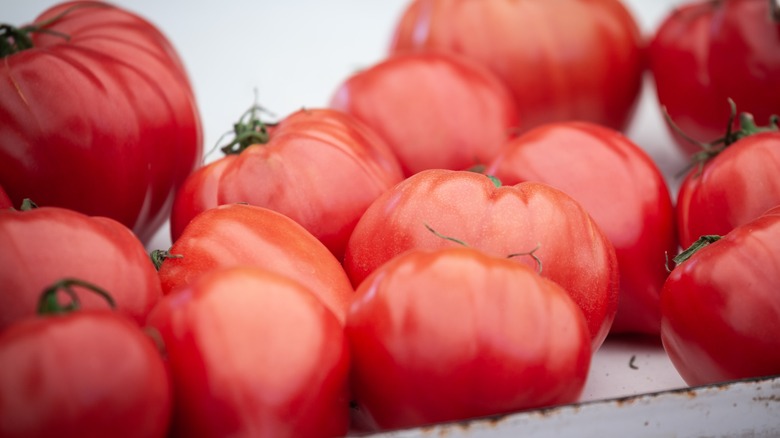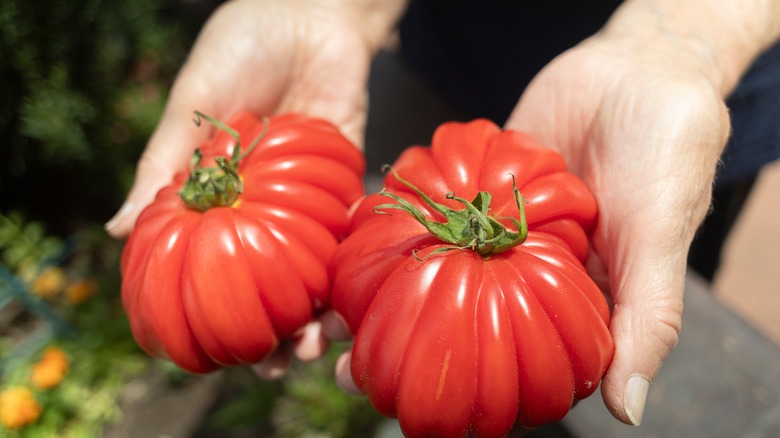What Exactly Is A Beefsteak Tomato And Why Is It Called That?
With tomato season taking place from May to October, you may be wondering why there are so many options for the juicy fruit. Well, the answer is easy. It is because each type of tomato delivers a different taste, texture, and size, all of which are important to consider when it comes to using the produce in recipes.
For example, there are plum tomatoes, which are often the base in pasta sauces and commonly found in canned tomato products, like the bougie San Marzano brand. There are cherry tomatoes — one of the main ingredients in the viral feta pasta dish. And what about cocktail tomatoes? Their short cooking time and burst of sweetness make them great for roasting and salads.
Then there is the superior tomato: the beefsteak tomato. Known for its large size and firm interior, this tomato has likely caught your eye in the produce aisle. But how did it get its name and what recipes does it work best in?
Beefsteak tomatoes have many distinct features
When you cut into a beefsteak tomato, you are likely to see several small seed chambers and large sections of firm inner walls branching from the center. That is because beefsteak tomatoes distinctly have smaller cavities, which house the plant's seeds and signature jelly-like substance, than other varieties.
When looking to identify a beefsteak tomato from its exterior, look for a tomato that is very large. These plants can grow to be over six inches and often weigh one pound or more. While traditionally, they are red and shiny and sometimes give off a ridged appearance (from their growing conditions), they can also come in different colors. In fact, there are about 350 types of beefsteak tomatoes out there and they come in colors like pink, yellow, green, and white.
But why is it called beefsteak? The definition of the word is often related to meat products. Merriam-Webster defines beefsteak as "a steak of beef usually from the hindquarter." It turns out that beefsteak tomatoes derive their name from their "meaty" interior. But do not fret, there is no actual meat in this fruit.
What recipes do beefsteak tomatoes work best in?
Since beefsteak tomatoes are known for their satisfying crunch and firmness, the variety shines in sandwich recipes. They are large enough to produce big slices and are less watery, so it doesn't add a soggy texture. Simple, Southern-style tomato sandwiches are often made with beefsteak tomatoes. All the recipe requires are tomatoes, white bread, mayonnaise, salt, and pepper, so it is ideal that the best tomatoes are harvested. For the same reasons, the tomato also works well as a burger topping.
Beefsteak tomatoes pair well with different cheeses, so they can be enjoyed in a Caprese recipe that alternates thick tomato slices and chunks of mozzarella. To bring out the tomato flavor in no-bake recipes, be sure to sprinkle the tomato slices with salt before preparing the dish.
Other recipes for beefsteak tomatoes include stuffing them, similar to the more common stuffed bell pepper. Given their large size, they can fit tons of toppings like ground beef, rice, and squash. To prepare the dish, just scoop out the center of the tomato and fill it with your desired toppings while using an egg to bind the ingredients. Then, top them with breadcrumbs for a crunchy finish. Beefsteak tomatoes can also be roasted in halves or quarters with a sprinkle of herbs to go with savory dishes like eggs and potatoes or a Sunday roast.


